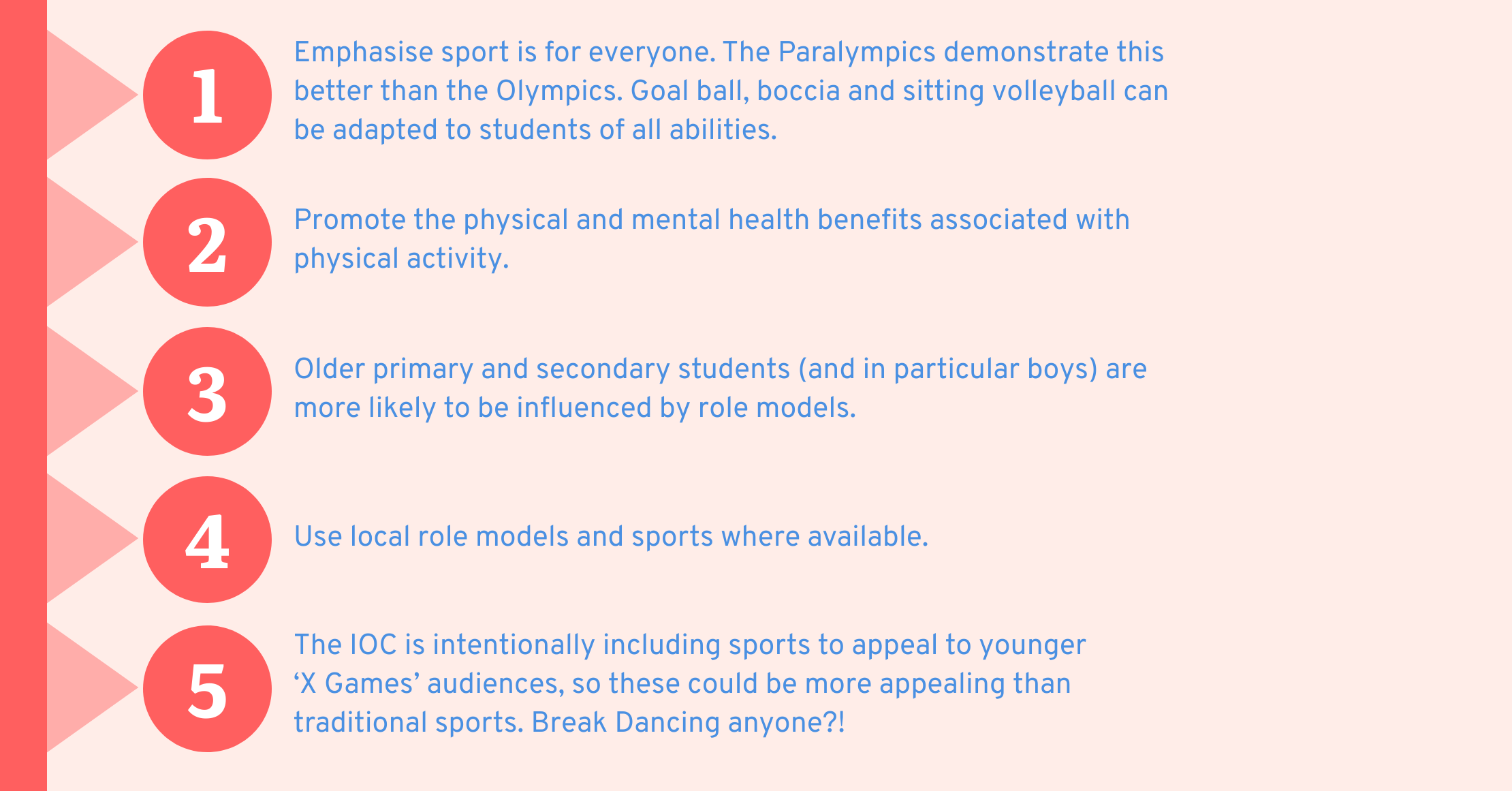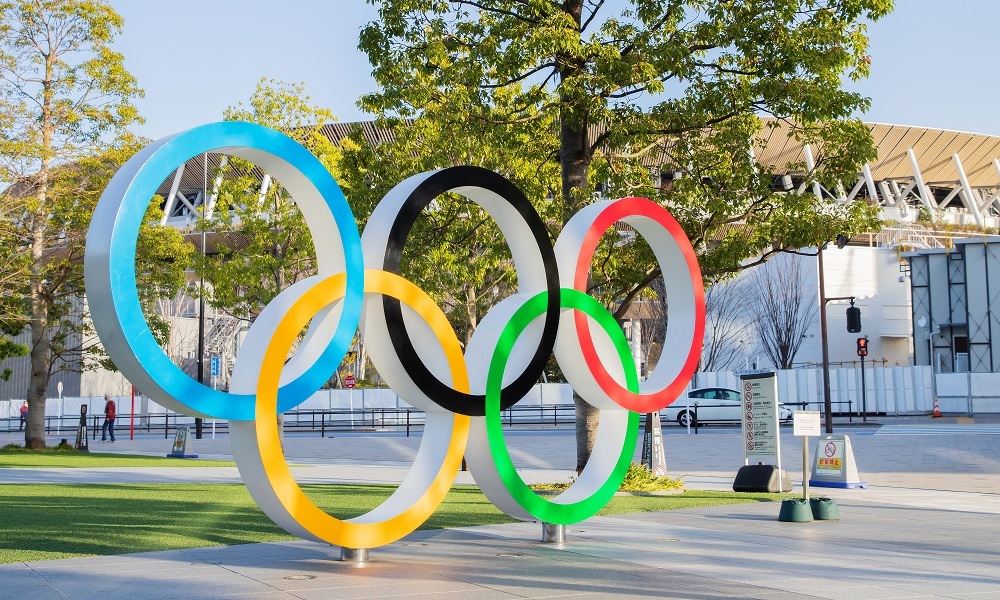This year the Tokyo Olympic Games will feature a record 33 competitions and 339 events, while the Paralympic Games will feature 539 events across 22 sports.
After an unprecedented one-year postponement, the Tokyo Olympics and Paralympics are scheduled to begin on 23 July and 24 August. While billions of fans around the world tune in to their favourite sporting moments from home, the question remains – Does elite sport performance act as a catalyst to increased mass sport participation? In today’s Q&A, we pose this question (and many more) to Dr Danya Hodgetts, an Adjunct Research Fellow with CQ University. She has a number of research papers on the topic of sporting event legacy at different stages of the peer review publication process. She shares some of the research she’s done, explains how the word ‘legacy’ became part of the Olympic lexicon, and shares five helpful hints for teachers wanting to embed the Games into their classroom practice this month.
Let’s jump straight in, do the Olympic and Paralympic Games inspire more people to participate in sport?
The answer is a big no, with a small yes. It does seem counterintuitive and I remember having this argument with my PhD adviser early in my research career who said… ‘Of course watching the Olympics inspires us to be more active!’ This was one of the few instances he was wrong!
Initial findings (Hodgetts & Duncan, 2013) from some research (that is currently in the peer review publication process) help explain this. We collected data just after the London 2012 Olympic Games from 1256 Queensland adults. Of these, only 78.7 per cent consumed Olympics coverage. Of the people watching the Olympics, 70.3 per cent said that it didn’t even make them feel like exercising. When we asked about actual exercise, 2.5 per cent said the Olympics actually made them do more exercise, and 8.5 per cent said it made them do less! In terms of actual benefit, 1.3 per cent of our initial sample weren’t previously doing enough physical activity (>150 active minutes per week), but were motivated by the Olympics to do more.
We asked why the Olympics did (or didn’t) motivate people to be more active. Those who were more active said they were inspired by the athletes or sports, were generally inspired, or were reminded of the importance of health and exercise. An unexpected response from a number of people was the inspiration they got from watching the Paralympics. Those who were not motivated cited a lot of the common barriers to physical activity (age, injury, time, energy, cost). Others weren’t interested in the particular sports, considered the Olympics to be entertainment, or were discouraged by the skill of elite athletes.
Is it true that host countries of the Olympic and Paralympic Games plan to deliver a legacy of increased mass sport participation in their countries? Has any host country ever done this effectively?
Legacy has only become part of the Olympic lexicon recently. London 2012 was the first organising committee who included legacy outcomes in their bid document and were aiming to get two million people more active before 2012 (Department for Culture, Media and Sport, 2008). Due to a change of government in the lead-up to the Olympics, many of the legacy programs were abandoned. A research paper I contributed to looked at the comparative legacy of Sydney, London and Rio (Reis et al., 2017). We concluded that sport participation legacies will only be achieved if host governments engage the community, develop long-term strategies, and coordinate efforts between different government portfolios and with a range of relevant stakeholders. Not a simple job!
By its nature, the Olympics are focused on elite sport, and currently in Australia government funding for elite sport is directly linked to on-field sporting success. This means expecting the Olympics to assist all sport participants is not going to work; it’s a broader government and societal role. Another difficulty is the complexity in developing and measuring large-scale physical activity programs. We know that Australians aren’t doing enough exercise, but we also know that the barriers prohibiting participation are complicated with no quick fix. Addressing this requires a permanent and sustained effort, not a quadrennial burst.
The concept that elite sports performance will positively impact on mass participation is often referred to as the ‘trickle-down’ or ‘demonstration’ effect. How does this work?
Trickle-down is probably the most apt term for this effect, because when you look at the previously mentioned data on adults who became more active after watching London 2012 – it is really just a trickle! When we try to apply big sporting events like the Olympics to behavioural models that explain why people take up physical activity or sport, it is difficult to make them fit.
What do we need to try and bring about the rise of the couch potatoes? Firstly, the event needs to be leveraged: there needs to be specific strategies to get people more active. Without active leveraging strategies, we are relying on a passive, almost osmotic process and we have seen that this doesn’t work. Some behavioural research has shown that those few who do increase their sport or physical activity levels are already active in some respect. For example, we do get an ‘Australian Open effect’ in January or February, but these are usually people who have already played tennis.
The other research worth considering are whole of community physical activity interventions, which are easier said than done (Mummery & Brown, 2009). Successful programs, such as the 10 000 Steps Program, require targeted mass media campaigns, community participation, educational events and even changes to the community’s physical environment. This is well beyond the remit of an Olympic Games organising committee, who has a very specific (and complicated!) event to deliver with a definite end date. A comparative study between the Sydney, London and Rio Olympics done by myself and some colleagues suggest that leveraging this legacy requires a whole of government long-term strategy that engages a broad range of stakeholders. Stakeholders include national sport organisations, but also local government, community organisations and schools.
Considering the behavioural construct of self-efficacy shows that there can also be a discouragement effect, where people are put off by a barrage of seemingly inhuman feats. We are constantly reminded that Olympics is derived from Olympus, the home of the Grecian gods! It makes us mere mortals think it’s easier to watch them from the comfort of our couch.
Some people argue that elite athletes become role models and attract new participants to sport. Have you found this to be the case in your research?
The use of role models has its difficulties, with the positive performance of role models both on and off the sporting field being important determining factors. This is also made difficult in an event like the Olympic Games, where time zone differences and broadcast access make it difficult to control in advance what a particular role model’s exposure and message will be. We just don’t know who’s going to pop up and win us over, so it’s difficult to plan for.
Looking at the behavioural research, role models are more likely to be effective with children, and again children that are already physically active. Boys are more likely to be influenced by successful athletes, while girls are more likely to look to parents, teachers or peers as role models (Vescio & Crosswhite, 2005; Payne et al., 2003; Lines, 2007).
Logistic regression of the Queensland adult London 2012 demographic data showed that age was a significant predictor of intention to exercise, while education level, gender, physical activity levels and BMI were not. This suggests that the younger a person is, the more likely they were to be influenced by this type of messaging. Some unpublished data I collected during the Glasgow 2014 Commonwealth Games on five- to 11-year-olds found that increasing age had an impact on the viewing of the event and doing more sport due to the event. A recently published study (Potwarka et al., 2021) looked at youth in Canada and found a positive association between a local role model winning a medal at London 2012 and physical activity levels of youth in that area.
I did some work with Cycling Australia in the lead-up to London 2012, where they were expected to (and did) perform well. Using the behavioural change and participation research, we created a club resource to assist them in attracting new members and re-engaging with lapsed members. Clubs with local representation will get an extra boost, but again, until the Olympics are on, we don’t know who they are going to be.
Given all of this, how do organisers of the Olympic and Paralympic Games get more people, young and old, involved in sport as a consequence of watching the Games from home?
In reality, we know that it isn’t a case of ‘build it and they will come’. The Olympic Games organisers provide the event, but capitalising on it can really be done by anyone! I did some legacy work with Surfing Australia and their surf schools to help prepare them for a possible increase in demand with surfing being a new sport for Tokyo this year. We looked at specific market segments they could target and possible products they could offer. A tricky caveat with this is the International Olympic Committee (IOC) and its national Olympic committees are very protective of their intellectual property! So, while surf schools can promote themselves around the time of the Tokyo Games, they need to use caution.
Danya Hodgetts’s five hints for leveraging the Olympics with students

References
Department for Culture, Media and Sport. (2008). Before, during and after: making the most of the London 2012 Games. DCMS.
Hodgetts, D., & Duncan, M. J. (2013). Examining the influence of the London 2012 Olympic Games on physical activity in Australian Queensland adults. Presented at the Sport Management Association of Australia and New Zealand, Dunedin.
Lines, G. (2007). The impact of media sport events on the active participation of young people and some implications for PE pedagogy. Sport, Education and Society, 12(4), 349–366. http://doi.org/10.1080/13573320701464234
Mummery, W. K., & Brown, W. J. (2009). Whole of community physical activity interventions: easier said than done. British Journal of Sports Medicine, 43(1), 39–43. http://dx.doi.org/10.1136/bjsm.2008.053629
Payne, W. R. R., Reynolds, M., Brown, S., & Fleming, A. (2003). Sports role models and their impact on participation in physical activity. Retrieved July 12, 2021, from https://www.researchgate.net/publication/255639009_SPORTS_ROLE_MODELS_AND_THEIR_IMPACT_ON_PARTICIPATION_IN_PHYSICAL_ACTIVITY_A_LITERATURE_REVIEW/link/0a85e53bd2525c580f000000/download
Potwarka, L., Ramchandani, G., Castellanos-García, P., Kokolakakis, T., Teare, G., & Jiang, K. (2021). Beyond the host nation: an investigation of trickle-down effects in the ‘Hometowns’ of Canadian athletes who competed at the London 2012 Olympic Games. European Sport Management Quarterly, 1-20. https://doi.org/10.1080/16184742.2021.1941182
Reis, A. C., Frawley, S., Hodgetts, D., Thomson, A., & Hughes, K. (2017). Sport participation legacy and the Olympic Games: The case of Sydney 2000, London 2012, and Rio 2016. Event management, 21(2), 139-158. https://doi.org/10.3727/152599517X14878772869568
Vescio, J., Wilde, K., & Crosswhite, J. J. (2005). Profiling sport role models to enhance initiatives for adolescent girls in physical education and sport. European Physical Education Review, 11(2), 153–170. https://doi.org/10.1177/1356336X05052894
How do you care for your own health and wellbeing? Do you have a story you’d like to share with Wellbeing by Teacher? Here’s a handy guide on how to get started.


